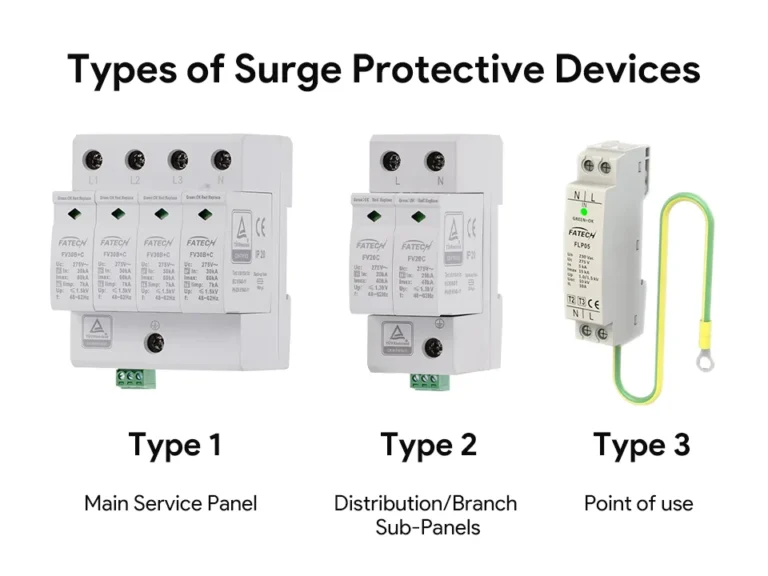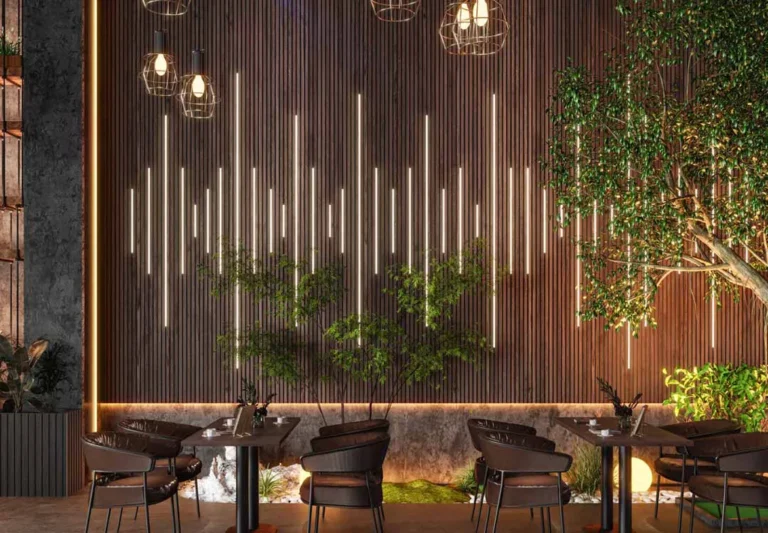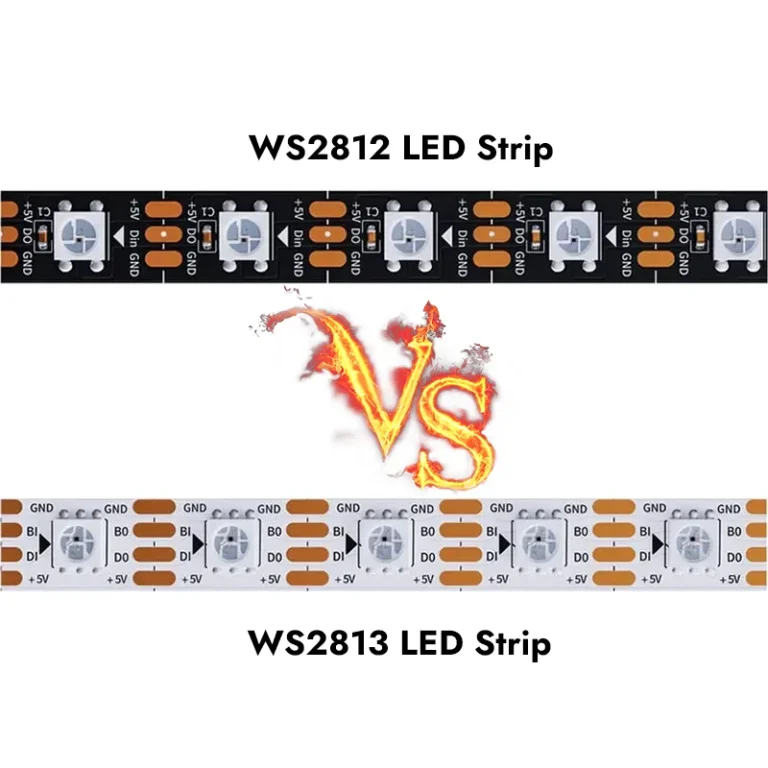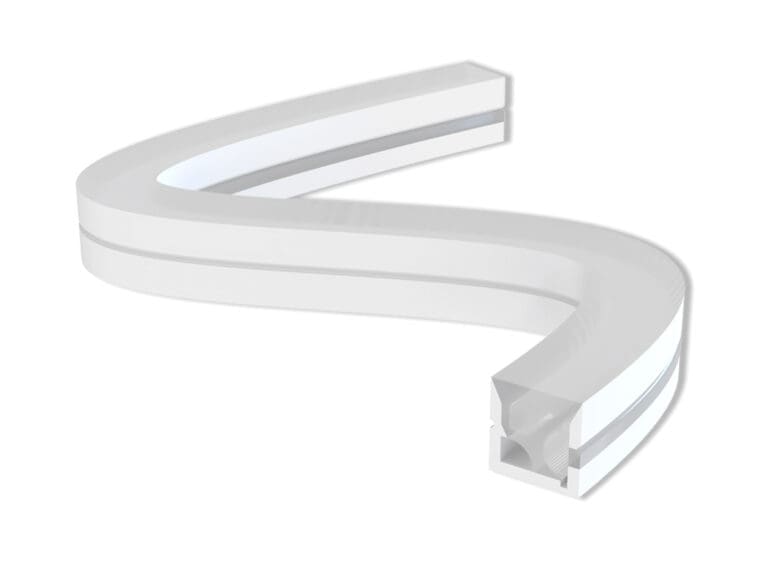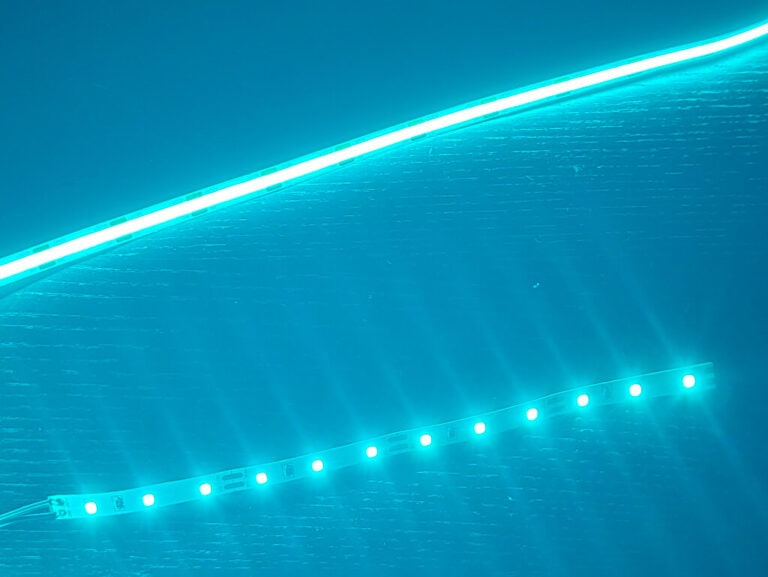動作中、LED スイッチング電源の瞬時高電圧 (サージ) は、落雷、グリッド スイッチング、モーターの始動/停止などの動作により、突然発生する「電流暗殺者」のように機能します。
これらのサージはほんの一瞬 (通常はミリ秒からマイクロ秒) しか持続しませんが、ピーク電圧は通常の電圧の 10 倍または数百倍に達することがあります。これは、半導体コンポーネントを破壊または焼き払うのに十分で、元に戻すことができません。
サージ保護は、グリッドの不安定性や落雷に対する LED 照明器具の「ライフライン」として機能します。 したがって、適切なドライバ電源を選択することが重要です。 必要に応じて、サージ プロテクターをフィクスチャに追加する必要があります。
この記事では、技術原則、エンジニアリング アプリケーション、およびインストール技術をカバーするサージ プロテクターの包括的な分析を提供します。
LED ライトのサージ保護装置とは何ですか?
サージプロテクターとは何ですか? 簡単に言えば、サージ プロテクターは回路内の突然の過電圧 (サージ) を「放電」し、照明システムの損傷を防ぎます。 回路内の「安全弁」のように機能します。電圧が制限を超えると、電流が急速に変化し、電圧が正常に戻るとリセットされ、LED 治具が常に安全な電圧範囲内で動作するようにします。
サージ プロテクタは、主に 2 つの典型的な「電圧サージ」シナリオに対応します。雷サージ、タイプ I およびタイプ II SPD、および産業機器の始動とシャットダウンによって生成されるスイッチング サージにより、電圧制限 SPD 保護が必要です。 どちらも基本的にデバイスの許容範囲を超えて遮断電圧を超え、電気機器の包括的な保護を提供します。
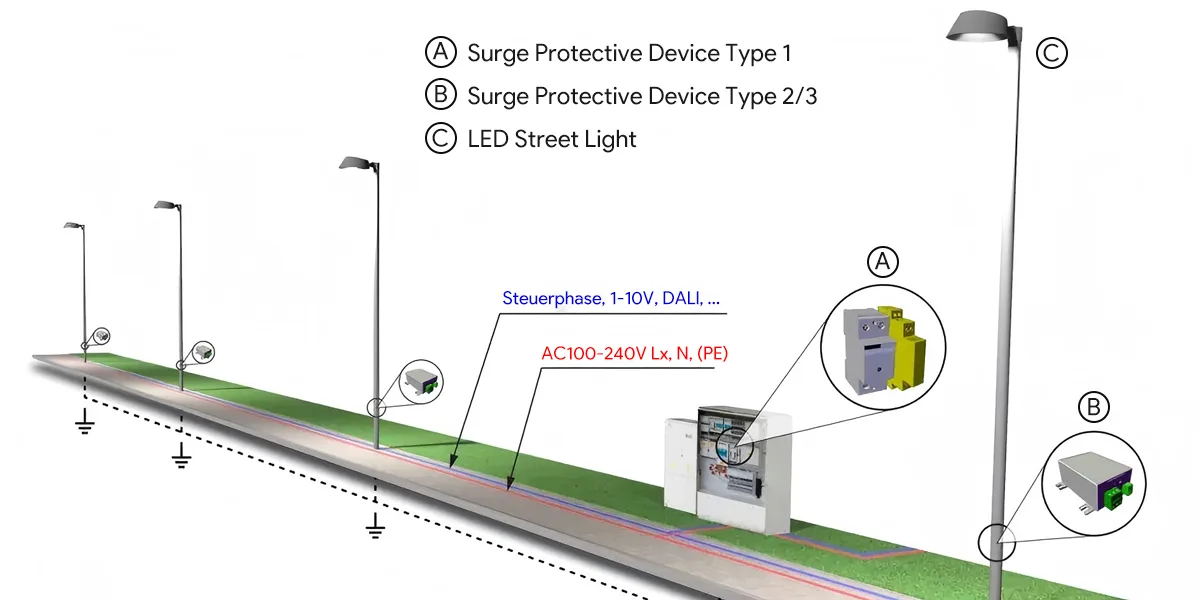
要約すると、サージ プロテクターは 2 つの目的を果たします。突然の高電圧による機器の損傷から、老化を加速する小さなサージを軽減し、LED 照明システムを包括的に保護します。
LED 照明アプリケーションのサージ保護デバイスの詳細については、次のブログをお読みください。LED 照明用サージ保護装置 (SPD): 屋内および屋外アプリケーションの完全ガイド。」
サージ保護装置にはどのような種類がありますか?
動作原理によって分類されます。
a) 電圧スイッチング SPD
通常動作中はインピーダンスが高く、電圧サージ中に急激に低インピーダンスにシフトし、大電流が流れます。 「短絡スイッチ タイプ SPD」とも呼ばれます。 通常、排出ギャップ、ガス放電管、サイリスタ、またはシリコン制御の整流器をコンポーネントとして採用します。 これらのサージ プロテクターは、不連続な電圧電流特性のため、「クロバ タイプ」とも呼ばれます。
b) 電圧制限 SPD
サージがない場合、高インピーダンスを示します。 サージ電流と電圧の増加に伴い、インピーダンスは連続的に減少します。 コンポーネントには、通常、バリスタと抑制ダイオードが含まれます。 「クランプ型」サージプロテクターとも呼ばれます。 連続電圧電流特性が特徴です。
c) 結合された SPD
電圧スイッチングと電圧制限コンポーネントを組み合わせたサージ プロテクター。 その特性は、印加電圧プロファイルに応じて、電圧スイッチング、電圧制限、またはその両方として現れる場合があります。
複合サージ プロテクターは、1 回の操作でシステムの最大動作電圧の 2 倍以下から 6kV を超えるサージ電圧を抑制できます。 3 相ユニットは 800V まで抑制でき、単相ユニットは 600V 未満に抑制できます。対照的に、モジュラー サージ アレスタは 3 レベルの保護 (クラス B、C、D) で約 1000V の抑制を必要とします。
アプリケーション別の分類:
アプリケーションに基づいて、SPD は、電力線 SPD と信号線 SPD の 2 つのタイプに分類できます。
サージ保護装置の構成
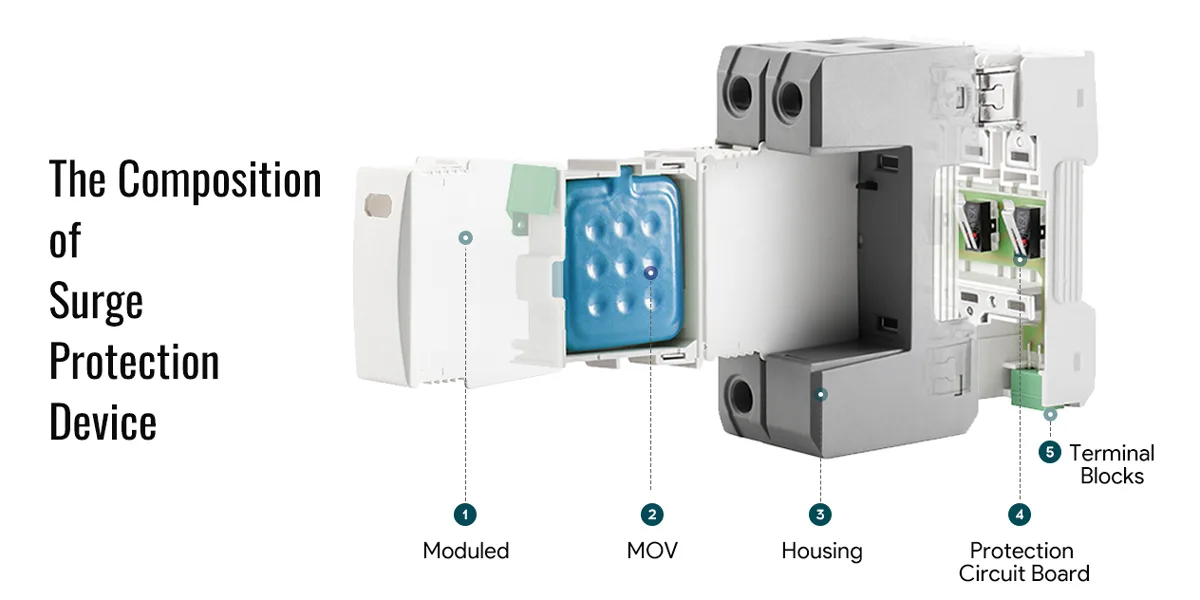
サージ プロテクター構造は、主に次のコンポーネントで構成されています。
- 金属酸化物バリスタ (MOV): 酸化亜鉛などの材料で作られるサージ プロテクターのコア コンポーネント。 回路で過電圧が発生すると、MOV は急速に導電状態に移行し、過電圧エネルギーを吸収して地面に向けます。
- 保護 Cサーキット Bはら: サージ プロテクターの内部にあり、電流と電圧の変化を制御および監視します。 通常、集積回路で構成され、サージ プロテクターの自動切り替え機能とリセット機能を実現します。
- ターミナル B錠前: サージ プロテクターを回路に接続します。通常、2 つの端子 (入力電源用と出力電源用) の 2 つの端子が付いています。
- 住居: サージ プロテクターの内部コンポーネントを保護します。通常、感電やその他の危険を防ぐために断熱材で作られています。
SPD と通常のヒューズとフィルタ回路の違い
SPD とヒューズの違い
SPD : 過渡サージ電流 (落雷、グリッド スイッチなど) を放散するように特別に設計されています。 高電圧サージを、金属酸化物バリスタ (MOV) やガス放電管 (GDT) などのコンポーネントを介して地面に導きます。機器を瞬時の高電圧損傷から保護します。
ヒューズ : 溶融によって回路を遮断することにより、持続的な過負荷または短絡電流のみに対処します。 ナノ秒レベルのサージは処理できません。
SPD の応答時間は、ナノ秒からマイクロ秒 (MOV の場合はナノ秒、GDT の場合はマイクロ秒) の範囲であり、ヒューズのブローにはミリ秒が必要であり、時間内に機密性の高い機器を保護できません。 劣化した SPD は、電流または短絡が漏れ、電流が漏れたり、電流が流れたりして、電流が流れない場合は、ヒューズ (サーキット ブレーカーではない) を使用して、電流の流れの危険を防ぐ必要があります。ブローヒューズは交換が必要ですが、その後の現在の問題は発生しません。
SPD とフィルター回路の違い
SPD : 落雷や電源サージなどの過渡高電圧 (KV レベル) から保護します。
フィルタ回路電源の電磁干渉など、持続的な高周波ノイズ (kHz-MHz) を除去します。
SPD は放電またはクランプ電圧 (たとえば、600V を超える MOV の導通) によって機能します。フィルター回路はインダクタとコンデンサを利用してローパス ネットワークを形成し、ノイズを徐々に減衰させます。 SPD は落雷やユーティリティ グリッドのサージから保護します。フィルター回路は、医療機器や通信システムなど、高純度の高純度を要求するアプリケーションに対応します。
要約比較表
| 機能 | spd | ヒューズ | フィルター 回路 |
| コア機能 | 放電の過渡サージ | 過負荷/短絡保護 | 高周波ノイズをフィルタリングする |
| 応答時間 | ナノ秒~マイクロ秒の範囲 | ミリ秒の範囲 | 連続運転 |
| 代表的なコンポーネント | MOV、GDT、TVS2 | 金属製ヒューズ | インダクタ、コンデンサ |
| 失敗のリスク | 漏れの可能性またはショート | 交換が必要 | パフォーマンスの低下 |
上記の比較で示されるように、SPD、ヒューズ、およびフィルタ回路はそれぞれ、電力システム内で異なる役割を果たします。 包括的な保護を実現するには、それらの協調的な使用が不可欠です。
サージ保護装置の動作原理
通常の状態では、サージ プロテクタは回路内のグランドに開放状態を示します。つまり、高抵抗状態を意味します。 この高抵抗特性により、回路への影響を最小限に抑えます。 スイッチのように機能し、干渉することなく正常な回路動作を確保するために必要のないときに開いたままです。 下の図 1 に示すように。
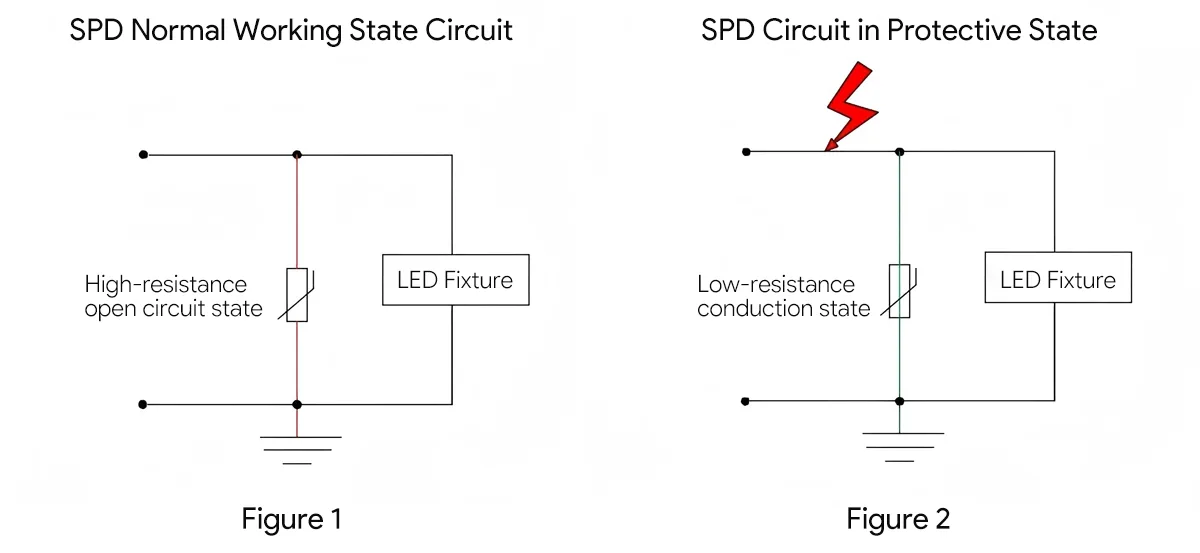
主回路で (落雷など) に過渡した高電圧が発生すると、サージ プロテクタが即座に応答します。 この過渡過電圧状態では、サージ プロテクタは低抵抗状態として動作します。 その内部コンポーネント (バリスタ、ガス放電管など) は、高抵抗状態から低抵抗状態に急速に移行し、導電性の経路を形成します。 サージ電流を即座に分岐させ、サージ電圧を安全なレベルに制限し、回路と機器を損傷から保護します。 図 2 に示すように。
図 2 に示すように、サージ プロテクタは過渡過電圧イベント時に重要な保護の役割を果たします。 これは障壁として機能し、過電圧の影響から電源と照明器具を保護します。
なぜ LED 照明システムのサージ保護が重要なのですか?
サージ保護は、次の主な理由から LED 照明システムにとって重要です。
1. サージに対する LED 感度
半導体デバイスとして、LED はわずか数ボルトの順電圧を持ち、非常に弱いサージ抵抗、特に逆電圧耐性が低い。 落雷やグリッドの切り替えによる過渡過電圧 (数千ボルトに達する) は、LED チップやドライバーに直接損傷を与え、即座に故障や潜在的な損傷を引き起こす可能性があります。
2. 多様なサージソース
- 雷誘導 : 雷電流の放電により、急激な接地電位サージが発生し、電源/信号線を介して照明器具に入ります。
- グリッド操作スイッチギア、短絡障害などにより、過渡過電圧が発生します。
- 静電気 私交信: 金属製のケーシングに蓄積された静電気 (>10kV) により、ドライバ回路が故障する場合があります。
3. サージ損傷の結果
サージ イベントは、LED 光源の老化 (発光効率の低下) を加速するだけでなく、カスケード障害を引き起こす可能性もあります。単一の LED 短絡により、電圧降下が隣接する LED に転送され、ランプのストリング全体の焼損が加速します。 屋外照明システムの高いメンテナンス コストは、不十分な保護を意味します。つまり、維持費が大幅に増加します。
ある都市では、30% の主要道路照明ドライバーがサージ プロテクションの欠如により雷雨の季節に失敗し、修理で 500,000 元以上が発生しました。 検査により、複数のサージの影響により、金属酸化物バリスタ (MOV) が老化および劣化し、その後の落雷によって LED モジュールが直接損傷したことが明らかになりました。
サージ保護は、LED 照明器具の寿命と信頼性を確保するための重要な手段であり、屋外や工業環境などのリスクの高い環境では特に不可欠です。 サージ保護を備えた LED フィクスチャは、信頼性が向上しています。 IEC 61000-4-5 などのテスト規格に準拠した SPD をインストールすると、メンテナンス コストが大幅に削減され、LED 照明システムにとって不可欠になります。
LED フィクスチャのサージ プロテクタの接続方法
サージ プロテクタを LED フィクスチャに接続する最も一般的なアプローチには、入力端子または出力端子に直列または並列に取り付けることが含まれます。 さまざまなインストール場所と方法に基づいて、これらは次のように分類できます。
1. サージプロテクターが組み込まれています 運転手s
内蔵のサージ プロテクターは、落雷、スイッチング操作、またはシステムへの静電気放電による過渡過電圧の影響を軽減します。 電源の安定性を維持し、照明システムの継続的な動作を保証します。 過渡過電圧に迅速に対応して抑制することにより、サージ プロテクタは、電圧異常による LED ドライバ モジュールや発光モジュールの損傷を軽減し、装置全体の寿命を延ばします。

2. に取り付けられたサージプロテクター 運転手 前端
このアプローチは、主に落雷が多く、環境湿度が高い地域に適しています。 たとえば、街路灯の前端にサージ プロテクターを取り付けると、落雷や電磁干渉による電気的損傷に対する保護が強化され、二重の保護手段として機能します。 また、後で簡単にメンテナンスできるようになります。 ただし、新しく追加された SPD が既存のシステムの接地方法と互換性があり、一致していることを確認することが不可欠です。

3. 入力時の直列接続
サージ プロテクターを LED ドライバの電源入力と直列に接続します。 入力でサージが発生すると、サージ プロテクタが電流の流れを遮断し、LED ランプを保護します。
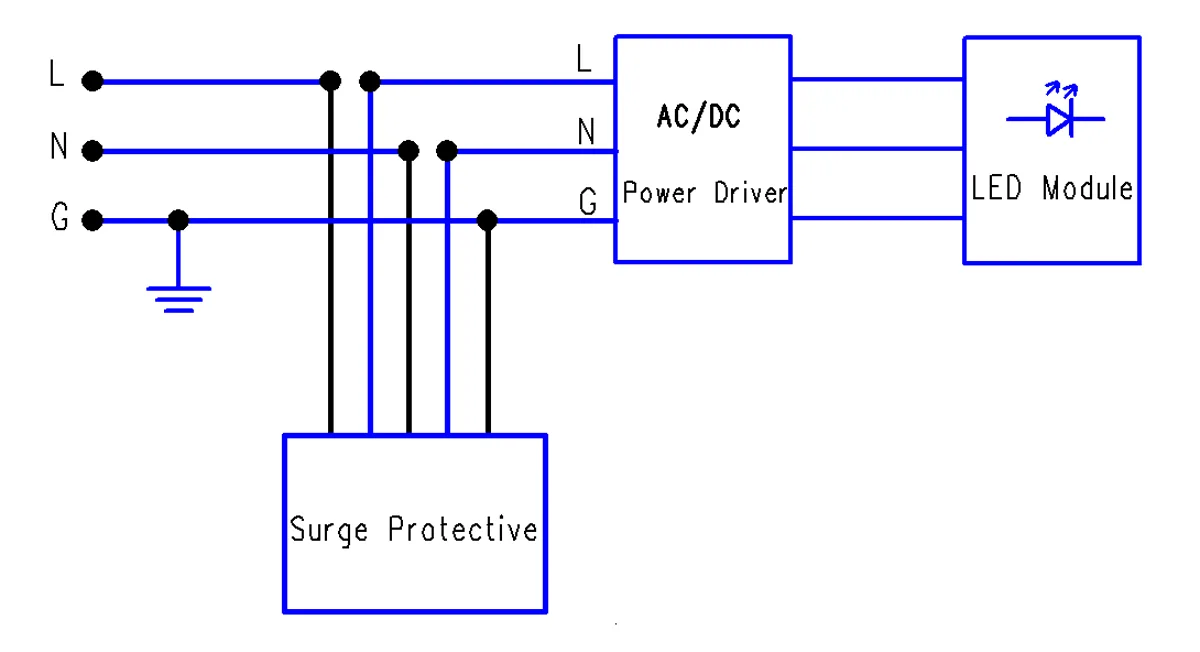
4. 入力時の並列接続
サージ プロテクターを LED ドライバーの入力と並列に接続します。 サージが入力で発生すると、サージ プロテクタが電流を流して過電流を流します。
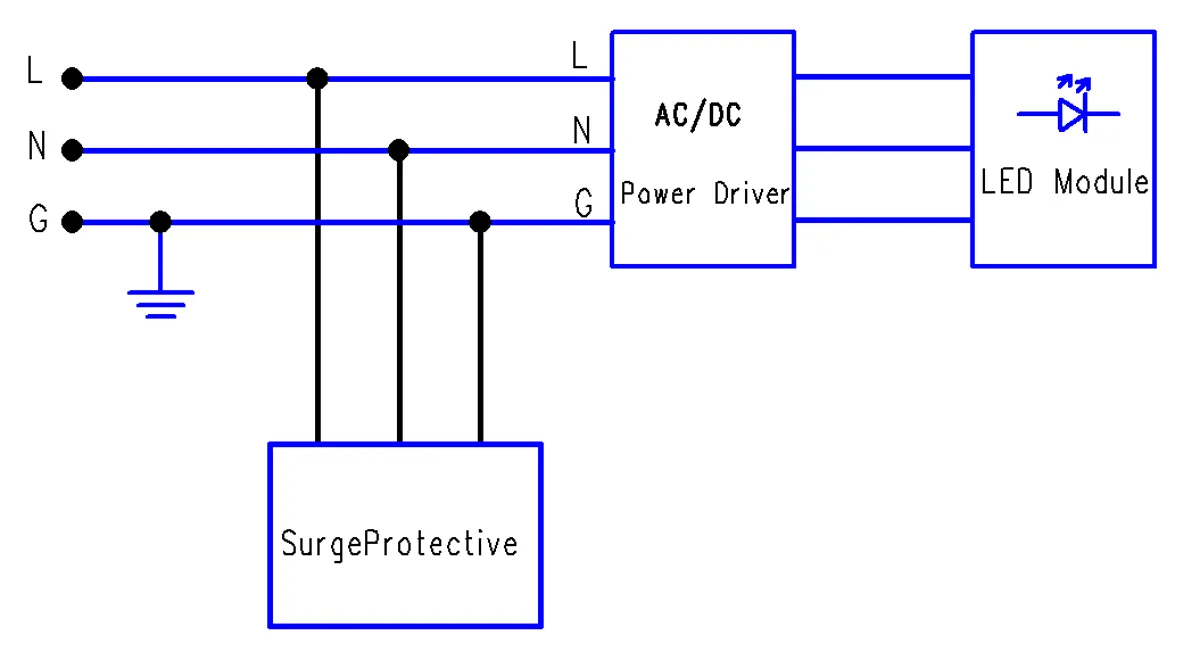
サージ プロテクターの種類が異なれば、それぞれの条件に基づいて選択する必要があり、それぞれの利点と欠点があります。
通常、シリーズ サージ プロテクターは、応答時間も速く、保護が強く、通常の操作での影響を最小限に抑えますが、複雑な設置、スペースの要件、損傷を受けやすいなどの欠点があります。
並列サージ プロテクターは、簡単な設置、コンパクトなフットプリント、交換の容易さを備えていますが、応答時間が遅くなり、保護が弱く、通常の動作による干渉が発生する可能性があります。
LED 照明にはどのタイプの SPD が使用されていますか?
サージ保護装置 (SPD) は、主に、保護機能、設置場所、および波形の許容特性に基づいて分類されます。 国際規格は、通常、次の 3 つのタイプに分類されます。
タイプ 1 SPD
建物のメインの配電盤または動力の入り口に設置された、直接落雷や高エネルギーのサージ用に設計されています。 1.5kV から 4kV の範囲のより高い電圧保護レベル (Up) を備え、通常、公称放電電流 (IN) は通常 12.5kA から 200kA の間です。
典型的なアプリケーション: 産業プラントや通信基地局など、直接落雷が発生しやすいリスクの高い場所。
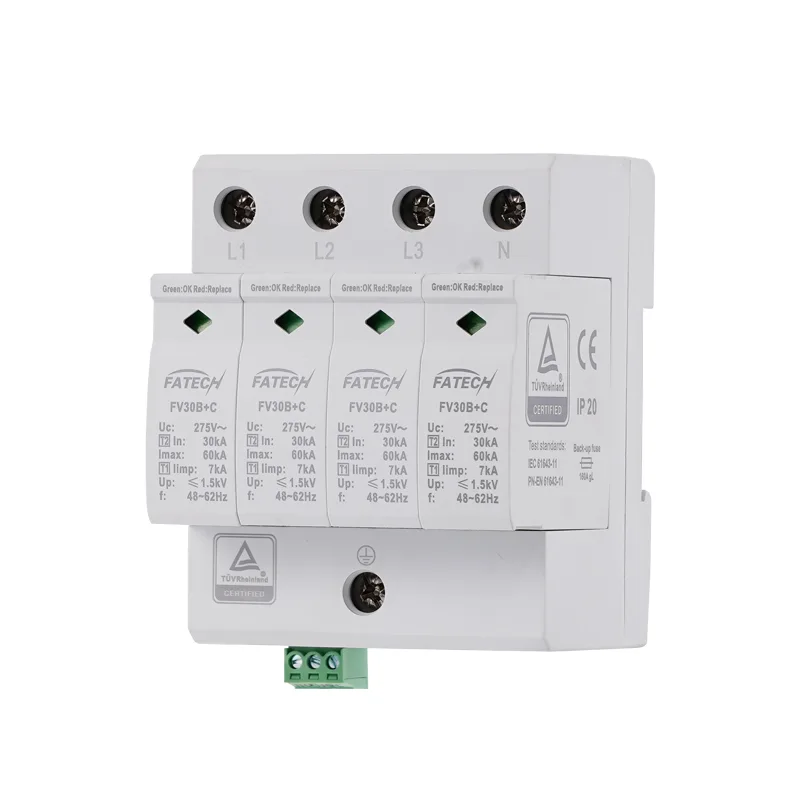
モデル。いいえ .: FV30B+C/4-275S
SPD 保護は、IEC 61643-11/EN 61643-11 に準拠しています。 タイプ 1+2
SPD の取り付けタイプは、IEC 61643-11/EN 61643-11 に準拠しています。 クラス I+IL
保護レベルは DIN VDE0675-6 に準拠しています。 b+c
ネットワークの種類: tt、tn
保護モード: L1、L2、L3、N-PE
公称電圧 UN: 220/380 AC/50(60)Hz
最大連続動作電圧 UC: 275 VAC/50(60)Hz
最大放電電流 (8/20μs) IMAX: 60カカ
公称放電電流 (8/20μs) で: 30カ
連続動作電流 IC: 20 μA未満
スタンバイ電力 PC: ≤25 MVA
電圧保護レベルアップ: ≤1.5 kV
応答時間 TA: ≤25 ns
取り付けタイプ: 35mm DIN レールは EN 60715 に接続されています
保護の程度: IP20
住宅の材料: UL94V-0
タイプ 2 SPD
配電盤や床面配電盤に設置された間接的な落雷や送電網の障害に適しています。 通常、IN は 5KA ~ 20KA で、UP は通常 1.5kV ~ 2.5kV です。
典型的なアプリケーション: 屋外および商用の LED 照明アプリケーション、道路照明、駐車場照明、壁面照明、交通照明、洪水照明、デジタル サイネージ、ストリート フラッシュ照明、トンネル照明など、LED の標識と信号機メーカー。
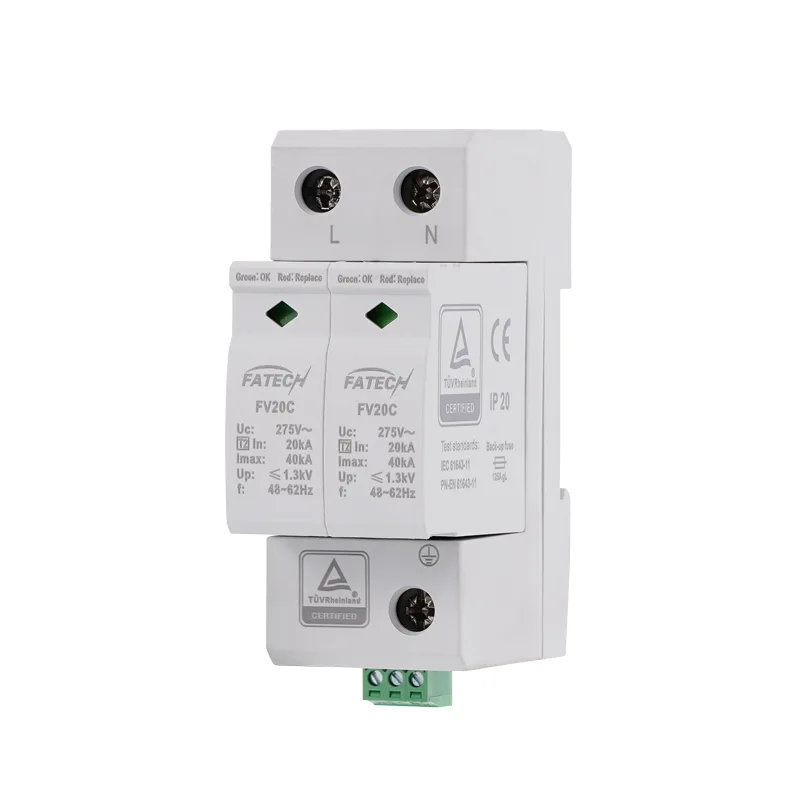
モデル。いいえ .: FV20C/2-275S
SPD 保護は、IEC 61643-11/EN 61643-11 に準拠しています。 2型
SPD の取り付けタイプは、IEC 61643-11/EN 61643-11 に準拠しています。 クラスIL
保護レベルは DIN VDE0675-6 に準拠しています。 C
ネットワークの種類: tt、tn
保護モード: L→PE、N→PE
公称電圧 UN: 230 VAC/50(60)Hz
最大連続動作電圧 UC: 275 VAC/50(60)Hz
短絡耐性機能 ISCR: 20カ
最大放電電流 (8/20μs) IMAX: 40カ
公称放電電流 (8/20μs) で: 20カ
連続動作電流 IC: 20 μA未満
スタンバイ電力 PC: ≤25 MVA
電圧保護レベルアップ: ≤1.3 kV
応答時間 TA: ≤25 ns
取り付けタイプ: 35mm DIN レールは EN 60715 に接続されています
保護の程度: IP20
住宅の材料: UL94V-0
タイプ 3 SPF
機器またはコンセントの前端に設置されたエンド デバイス保護に適しています。 通常は 10kA 以内で、より高速な応答時間 (ナノ秒レベル) で微細な保護 (最大 1 kV) を提供します。
典型的なアプリケーション: ローカル電圧保護のために LED ドライバに組み込まれることがよくあります。
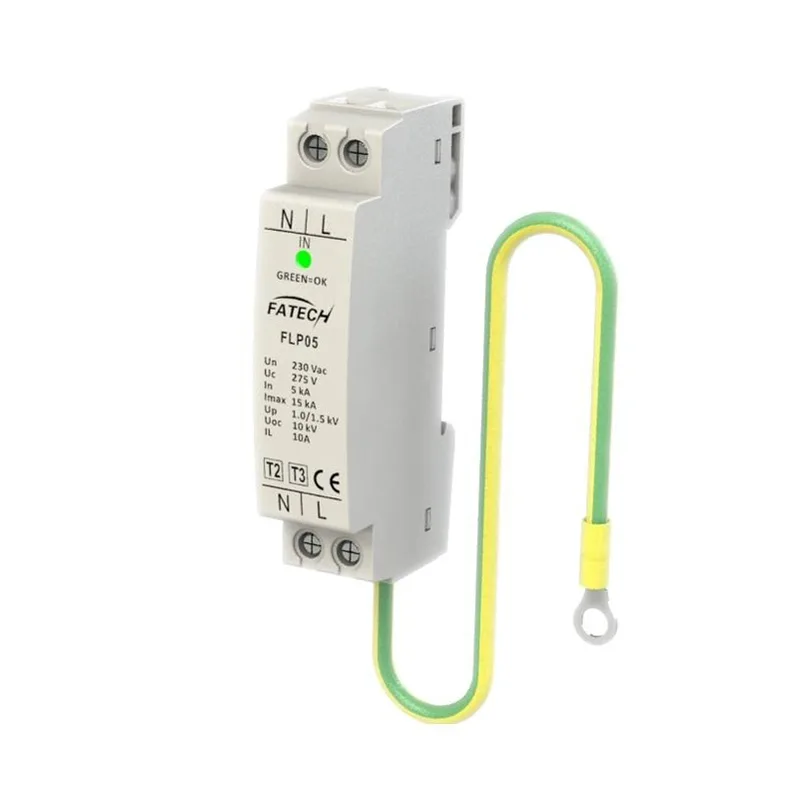
モデル。いいえ .: FLP05-275I-D
SPD 保護は、EN 61643-11 に準拠しています。 タイプ 2+3
SPD のインストール タイプは、EN 61643-11 に準拠しています。 クラス IL+III
保護レベルは DIN VDE0675-6 に準拠しています。 C+D
ネットワークの種類: LEDライト
保護モード: L-N、N-PE、L-PE
公称電圧 UN: 230 VAC/50(60)Hz
最大連続動作電圧 UC: 275 VAC/50(60)Hz
最大放電電流 (8/20μs) IMAX: 15カ
公称放電電流 (8/20μs) で: 5か
電圧保護レベルアップ: ≤1.5 kV
応答時間 TA: ≤25 ns(L-N)
取り付けタイプ: 35mm DIN レールは EN 60715 に接続されています
保護の程度: IP20
住宅の材料: UL94V-0
一般的なメインの配電パネルはタイプ 1 またはタイプ 2 のデバイスを使用します。配布ボックスは、タイプ 2 およびタイプ 3 のデバイスを使用でき、タイプ 2 およびタイプ 3 はバックエンド アプリケーションにも適しています。
建物に入る AC 供給ラインの場合、LPZ0A/LPZOB と LPZ1 ゾーンの間 (メイン配電盤など) の境界に、タイプ 1 またはタイプ 2 サージ プロテクターを一次保護として取り付けます。
配電線や電子機器室の配電盤など、後続の保護ゾーンの境界では、タイプ 2 サージ プロテクターを二次保護として設置することができます。 LED 照明器具などのデバイスの場合、タイプ 2 またはタイプ 3 サージ プロテクターを電源ポートの前に取り付けることができます。
サージプロテクターを正しく選択するには?
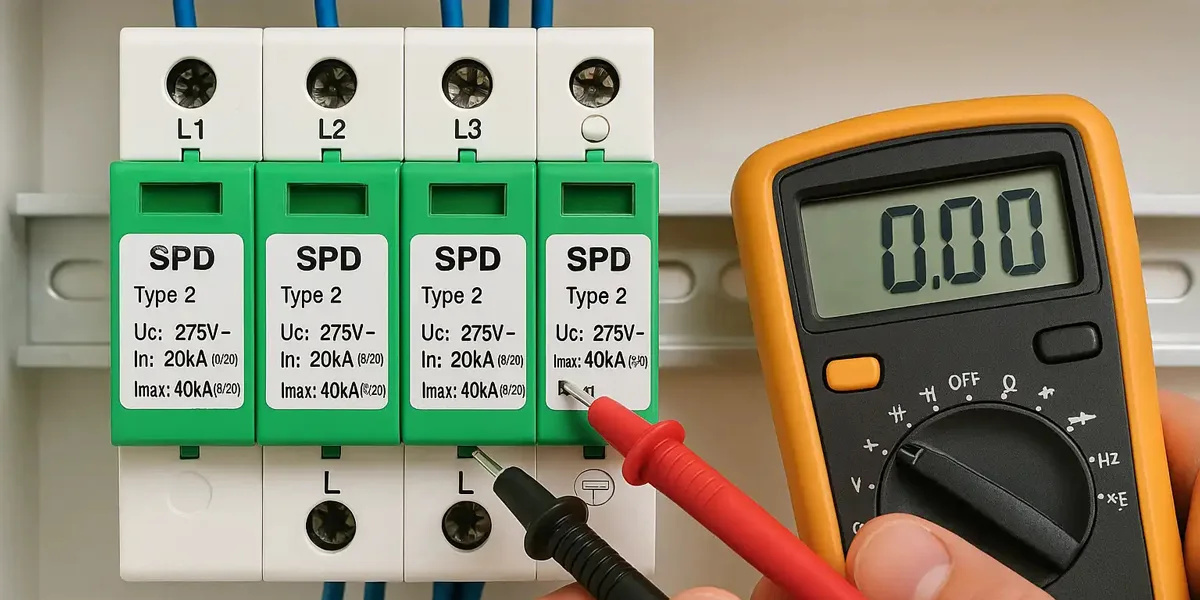
電気アプリケーションでは、サージ プロテクタの選択は、システム グランドの構成、露出レベル、雷保護ゾーン、ケーブル長、レベル間保護、保護点での短絡電流の大きさ、およびシャント回路の数などの要因を含む非常に複雑な問題です。
多くのメーカーが市場でサージ プロテクターを製造しています。 したがって、サージ保護装置を選択する際には、次の点に特に注意する必要があります。
1. UC 値を決定する
サージ プロテクタの最大連続動作電圧 (UC) を選択するには、システム電圧、機器耐圧、および標準仕様を包括的に考慮する必要があります。 UC の最小値は、定格電圧の 1.15 倍にする必要があります。
たとえば、220V 相電圧システムでは、UC = 1.15 × 220V = 253V です。AC グリッドのピーク電圧は RMS 値の 1.1 倍 (253V × 1.414 = 357V で約 1.1 倍) に達する可能性があるためです。 220V システムの場合、350V ピーク)、UC はこの値を超える必要があります。 ただし、実際のアプリケーションでは、頻繁に起動するのを避けるために、385V などのより高い値を選択することをお勧めします。 同時に、バリスタの活性化電圧 (U1mA) はグリッドの変動範囲と一致する必要があります。
2. 保護レベルの選択
クラス I SPD (例: IIMP ≥ 100kA) はメイン配布に使用され、クラス II SPD (≥ 40kA) は配電パネルに使用され、マルチレベルの保護を形成します。 SPD の設置寸法とタイプは、オンサイトの要件を満たす必要があります。 選択ガイドラインは次のとおりです。
| 保護レベル | 設置場所 | アプリケーション・シナリオ | 主要パラメーター |
| 1型 | メイン配電盤 | 直接落雷防止 | ≥100kA(10/350μs) |
| 2型 | 配布ボックス | 誘導雷/操作サージ | 40KA(8/20μs) |
| タイプ3 | LED ドライバー フロント エンド | 精密機器端末保護 | ≤1.5 kV まで |
3. インストール方法
照明器具の位置に基づいて、正しく配置され、簡単に取り付けられる SPD を選択します。 SPD は通常、照明器具の前など、届きにくい場所に隠されているため、故障時に照明器具を回路から切り離して、将来の交換やメンテナンスを容易にすることができます。
4. 環境への適応
屋外照明の場合は、IP54 以上の IP 定格の SPDS を選択します。 湿気の多い、またはほこりの多い状況では、IP67 のより高い IP 評価の SPD を使用してください。
5. 接地仕様
SPD は専用の PE 端子を介して接地され、出射線による共有接地経路を避けてください。 接地導通抵抗試験 ≤0.1Ω。
6. マルチレベルの保護
230V 電源装置を保護する以外に、DALI、第 2 段階 (制御) フェーズ、1-10V、または DMX などの制御ユニットを保護することを検討してください。 AC とコントロールの組み合わせ SPD は、これらのフィクスチャに最適で、通常、2 つの別個の SPD よりも優れた協調保護を提供します。
7です . 認証と安全性
IEC 61643-11 および VDE 0100-534 の要件を満たすためにテストされた、TUV や UL などの信頼できる認定を備えた SPD を選択してください。
結論
サージ保護装置は、落雷やグリッド サージに対する屋外照明システムの中核となる障壁として機能します。 バリスタとガス放電管の相乗作用により、高電圧サージをマイクロ秒以内に地面に向け、電圧を安全な装置のしきい値にクランプします。
適切な保護がなければ、LED フィクスチャとそのドライバーは、取り返しのつかない損傷、効率の低下、および完全な故障のリスクに直面します。 サージ保護装置は、過酷なグリッド環境での LED 街灯の信頼性を大幅に高め、スマート シティ照明システムに不可欠な保護コンポーネントを提供します。
